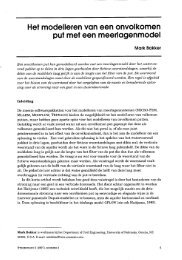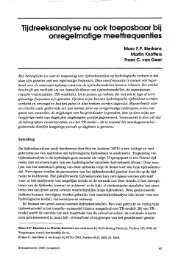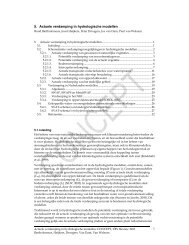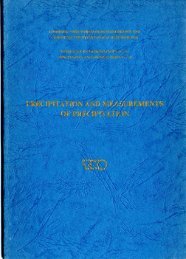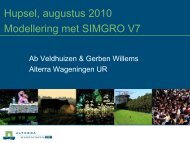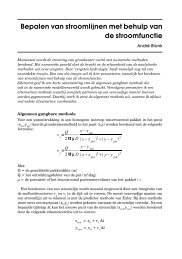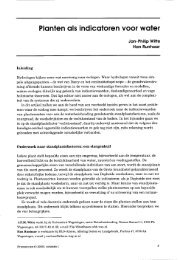Hydro-ecological relations in the Delta Waters
Hydro-ecological relations in the Delta Waters
Hydro-ecological relations in the Delta Waters
You also want an ePaper? Increase the reach of your titles
YUMPU automatically turns print PDFs into web optimized ePapers that Google loves.
In <strong>the</strong> terrestrial habitats it is of weat impartance how <strong>the</strong> nutrient<br />
cycles of <strong>the</strong> ecosystem and <strong>the</strong> structure of <strong>the</strong> vegetativn are<br />
<strong>in</strong>fluawed. The nutrient cycles detenatee grow<strong>in</strong>g and feed<strong>in</strong>g<br />
conditions for plant and animal species, whLle vegetation structure is<br />
of great iaqrortance for <strong>the</strong>ir survival. Rmtghly speak<strong>in</strong>g we can<br />
dist<strong>in</strong>guish three ways af nature managemeqt: spontaneous developdent.<br />
rcew<strong>in</strong>g and graz<strong>in</strong>g. Each of <strong>the</strong>se managerneat types has its om results<br />
and (f<strong>in</strong>ancial) costs. Sponfaneous development will lead to woodland<br />
ult<strong>in</strong>atelp, a l e mow<strong>in</strong>g keeps areas open and rich <strong>in</strong> herbs. Oraz<strong>in</strong>g is<br />
<strong>in</strong> between <strong>the</strong>se two types and <strong>the</strong> rcanlt depends on gra~<strong>in</strong>g <strong>in</strong>tensity.<br />
It is an attractive type of management to create a habitat with a<br />
~aried structure of grassland and shrubs <strong>in</strong> a semi-natural way. Graz<strong>in</strong>g<br />
anlmaLs l~ndigenrms herbivorous herds as well as domestic cattle) we<br />
large areas <strong>in</strong> traditihsl patterus. Some parts of <strong>the</strong> area are (year<br />
after year) more <strong>in</strong>tensively grazed than o<strong>the</strong>rs. In this way Faz<strong>in</strong>g<br />
can enlarge <strong>the</strong> differentiaties of <strong>the</strong> abiotic envirpmenc creat<strong>in</strong>g<br />
additional stimuli for mre diversity <strong>in</strong> develop<strong>in</strong>g ecosystems. In <strong>the</strong><br />
lens run it will not only result <strong>in</strong> grassland. Even for natural<br />
woodkd development grs<strong>in</strong>g (of course <strong>in</strong> very low densities) can be a<br />
good cyse of management.<br />
4 BALBNCE OF ECOSYSTEM DETFELBFXE4T UP TO BOW<br />
The fitst embankment of a large estuary <strong>in</strong> <strong>the</strong> South-West Ne<strong>the</strong>rlands<br />
tbok place some 30 years ago (Lake Veere, 1961). S<strong>in</strong>ce that time<br />
several othsr areas folloved. with difTerent abiotic enviroweuts and<br />
different types of water systeqts. As <strong>in</strong>dicated above ecosyste& i3evrlop-<br />
ment is still go<strong>in</strong>g on and eves <strong>in</strong> <strong>the</strong> oldeat aress it will take tens<br />
or even hunrtreda of years before <strong>the</strong> new t~rresrriai habitats will be<br />
stabilized. Notwithstand<strong>in</strong>g <strong>the</strong>se facts we ri1.l try to make up some<br />
balance fxom a p<strong>in</strong>e of view of nature conservativn and manaseoee.<br />
Firstly we wst natice that chere is a great loss of valuable (semi-)<br />
terresrrial habitats <strong>in</strong> <strong>the</strong> esttmfes of <strong>the</strong> South-West We<strong>the</strong>rlands as<br />
a consequaRce of <strong>the</strong> <strong>Delta</strong> Work$. (The lv,ags of aquatic ecosystems and<br />
tidsl flat6 is leet out of oonsideration.) After <strong>the</strong> enclosniuze of <strong>the</strong>





